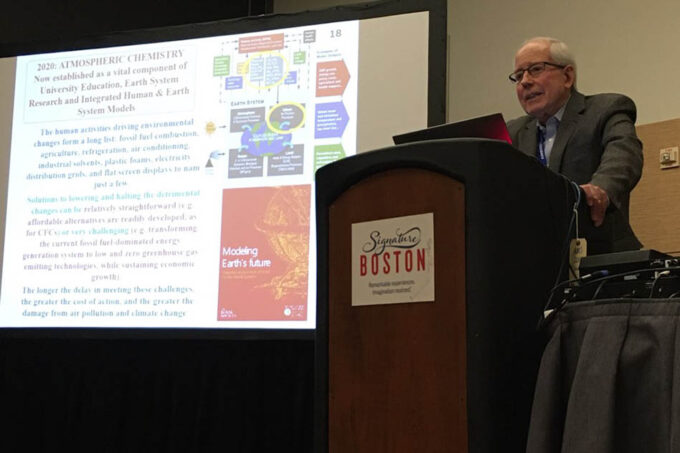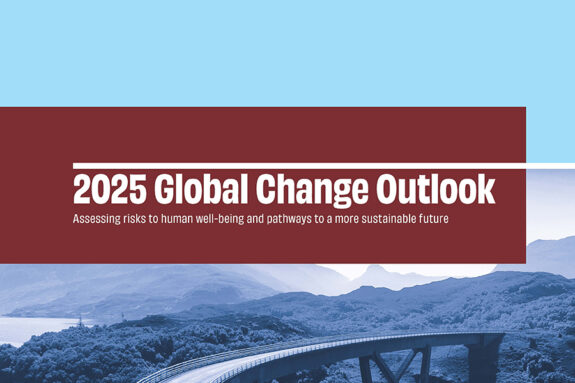One Hundred Years of Atmospheric Chemistry

MIT Professor Ronald Prinn presents highlights in science keynote at 100th Annual Meeting of the American Meteorological Society
Read this at MIT News.
MIT TEPCO Professor of Atmospheric Science Ronald Prinn described how the field of atmospheric chemistry has advanced from 1920 to 2020 in a core science keynote address at the 100th Annual Meeting of the American Meteorological Society, the world’s largest yearly gathering for experts in the atmospheric sciences. Speaking at the Boston Convention and Exhibition Center on January 14, Prinn, who directs the Center for Global Change Science and co-directs the Joint Program on the Science and Policy of Global Change at MIT, explored key developments in the field.
“The impressive evolution of atmospheric chemistry from the early 20th century to the present day has been driven by a mix of scientific curiosity about the air we live in and breathe on Earth, the desire to understand and mitigate the detrimental impacts of air pollutants and greenhouse gases to humans and the environment, and in the last half century, a parallel quest to understand the atmospheres of other planets,” Prinn said.
Starting with a brief history of the first 50 years of the period covering 1920 to 2020, he described how scientists, through expanding atmospheric measurements, laboratory studies and simple models, developed a more precise understanding of the chemistry of air pollution, the stratospheric ozone layer and the upper atmosphere. This evolving understanding led to the earliest air pollution regulations.
Prinn next focused on the past 50 years of atmospheric chemistry advances, a period in which he was an active participant in the field.
“This half-century has seen the careful observation of the rapidly growing size of human relative to natural influences on the atmosphere, and the more and more urgent need to mitigate the detrimental influences through regulation,” he said.
Beginning with the 1970s and 1980s, Prinn recounted the first pioneering studies of the detrimental effects of nitrous oxide, chlorofluorocarbon (CFC) and aviation nitric oxide emissions on the stratospheric ozone layer; the discovery of the Antarctic ozone hole and the chemical and meteorological processes that caused it; the human activities leading to these detrimental effects on ozone; and the subsequent passage of the Montreal Protocol to curtail those activities. He acknowledged the key roles in this early research of future Nobel Laureates Paul Crutzen, Mario Molina and Sherwood Rowland, along with other notable atmospheric scientists such as Harold Johnston, James Anderson, Susan Solomon and Joseph Farman.
As leader of the Advanced Global Atmospheric Gases Experiment (AGAGE, known as the Atmospheric Lifetime Experiment (ALE) when it was founded in 1978), Prinn led or co-authored papers that used atmospheric measurements to prove that the lifetimes of CFCs were long enough for them to release their ozone-destroying chlorine predominantly in the stratosphere—thus confirming a key assumption of a trailblazing Molina and Rowland study from the 1970s.
Prinn next observed that just as the atmosphere transcends national boundaries, atmospheric research expanded to become an international endeavor. This trend was spurred by the inception of the International Global Atmospheric Chemistry (IGAC) program in 1988, which sought to improve our understanding of the natural and anthropogenic processes underpinning the composition of the atmosphere, and of interactions among the atmosphere, biosphere and climate system. Such international cooperation led to more precise global measurements and better understanding of how and why the atmosphere was changing.
Citing data from AGAGE, NOAA and NASA, he traced the rapid evolution of atmospheric composition over the past 50 years driven by dramatic increases in anthropogenic emissions of greenhouse and ozone-depleting gases. Meanwhile, he noted, impressive increases in scientific knowledge and computational power accelerated advances in atmospheric modeling, providing powerful new tools with which to better understand and confront these challenges.
“The human activities driving these changes form a long list: fossil fuel combustion, agriculture, refrigeration, air conditioning, industrial solvents, plastic foams, electricity distribution grids and flat screen displays to name just a few,” said Prinn. “Solutions to lowering and halting the detrimental changes can be relatively straightforward (e.g. affordable alternatives are readily developed, as for CFCs) or very challenging (e.g. transforming the current fossil fuel-dominated energy generation system to low and zero greenhouse gas emitting technologies, while sustaining economic growth).”
But he emphasized that these latter challenges must be met as soon as possible. “The longer the delay, the greater the cost of action, and the greater the damage from climate change,” he said.
Prinn concluded the talk by noting that atmospheric chemistry is recognized today as an essential component of understanding and modeling the Earth’s integrated human-atmosphere-biosphere-land-ocean system, and of curricula in environmental science programs in universities around the world.
Story Image: MIT TEPCO Professor of Atmospheric Science Ronald Prinn delivering core science keynote at the 100th Annual Meeting of the American Meteorological Society (Photo by Mark Dwortzan)


